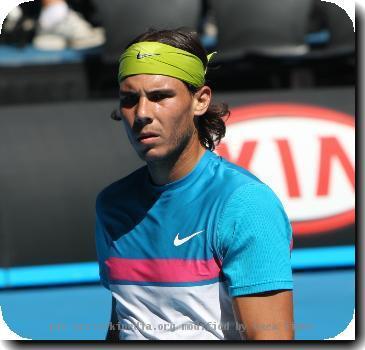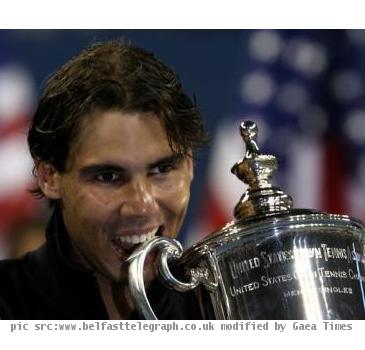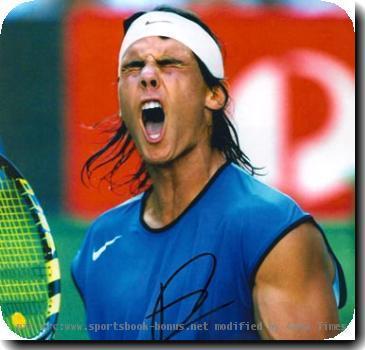Rafael Nadal gets one for the history books, completing career Grand Slam at US Open
By Eddie Pells, APTuesday, September 14, 2010
Finally, Rafael Nadal breaks through at US Open
NEW YORK — For seven years, Rafael Nadal deposited his share of skin and blood and sweat and effort on the imposing blue court in the middle of the biggest tennis stadium in the world.
At the end of the eighth year, he collapsed and rolled over, his face to the ground, exhausted while he celebrated — knowing that finally, he would take something away from the court where he’d left so much.
The top-seeded Nadal won the U.S. Open trophy and completed the career Grand Slam on Monday in a 6-4, 5-7, 6-4, 6-2 victory over No. 3 Novak Djokovic. Nadal became only the seventh player to win championships at all four majors. He has nine major titles overall, and having filled in the last big gap on his resume, the discussion now focuses on whether — or when — he can be considered the best of all time.
“I think the talk about if I am better or worse than Roger is stupid, because the titles say he’s much better than me,” Nadal said of Roger Federer, who has a record 16 Grand Slam tournament titles to his credit. “So that’s true at that moment. I think that will be true all my life.”
Time will tell, but time is on Nadal’s side.
He is 24 years old, five years younger than Federer, and has eclipsed the halfway mark to Federer’s record.
Federer could still add to his 16 and set the bar higher. But he is on the back end of his career. And all signs point toward Nadal being at or near his peak. Winning the season’s final major, the one in which he had never been past the semifinals before this year, was the strongest testament to that.
Long considered a clay-court specialist who later figured out how to win on the grass at Wimbledon, Nadal is one of those rare elite athletes who actually doesn’t make it look easy. He grinds. His sneakers squeak loudly with every change of direction. He whips his arms violently on every groundstroke. He sneers and smirks and grunts.
All this, the thought went, could never bode well for his chances at Flushing Meadows, where the hard, fast court, the softer ball, the wind, the crowd, the New York pressure and the cumulative effect of the long season always wore him down all too quickly.
This year, though, he came to the Big Apple as ready as he’d ever been.
“Players said Rafa could never win on hardcourt because he played too much topspin, he’s too physical,” said Nadal’s uncle and coach, Toni Nadal. “And now I believe there’s not much that the players he plays against can argue with.”
Nadal made it through his first six matches of the 2010 tournament — plagued by heat the first week, wind the second and rain at the tail end — without losing a set. The final had been scheduled for Sunday but got postponed a day because of rain. That certainly didn’t hurt Rafa, though the common thought was it would help Djokovic more because he had a grueling five-set semifinal against Federer on Saturday.
As Nadal expected, Djokovic was no pushover.
Nadal only got broken twice in 91 games during his run to the final thanks to a new-and-improved serve he worked on specifically for this tournament. But Djokovic broke him three times.
Nadal rallied from down 4-1 to 4-4 in the second set and had the momentum. But Djokovic had luck on his side. Just then, rain came and caused a 1 hour, 48 minute delay.
Nadal came back out after the delay and dropped the second set. Suddenly, Djokovic, the 2008 Australian Open winner who was 7-3 lifetime on hard courts against Rafa, looked like he had another upset in him.
This, however, was not meant to be for the Serb — an entertaining and worthy foe nicknamed “The Joker,” whose victory over Federer deprived tennis fans of the first Rafa-Roger final at Flushing Meadows. Djokovic left more impressed with the player he lost to Monday than the one he defeated two days before.
Federer “is still playing as one of the best players in the world,” Djokovic said. “The other hand, you have Nadal who is just proving each day, each year, that he’s getting better. That’s what’s so frustrating. He’s getting better each time you play him.”
Indeed, Nadal’s groundstrokes were too penetrating, his passing shots too precise, his serve either too big or too perfectly placed in the corners. He won a riveting third set despite squandering 10 of 11 break points.
The fourth set was reminiscent of the bullfights in his home country of Spain: There was the matador, Nadal, jabbing and poking and slowly, cruelly sapping the loser’s strength — and his will; and the bull, Djokovic, warbling dangerously between resignation and brief flurries of rage and effectiveness.
But when it was over, it was Nadal who crumpled to the ground — a brief moment to take all to himself, with several thousand of his closest friends looking on in 23,000-seat Arthur Ashe Stadium.
“For the first time in my career, I played a very, very good match in this tournament,” Nadal said. “That’s my feeling, no? I played my best match in the U.S. Open at the most important moment, so I am very, very happy for that, for sure.”
With his latest victory adding to the 2010 French Open and Wimbledon titles, Nadal stretched his Grand Slam winning streak to 21 matches. No man had won those three tournaments in the same year since Rod Laver won a true Grand Slam in 1969. Now Nadal heads to the Australian Open in January — played on a slower version of hard courts — with a chance to claim a Rafa Slam. Four straight majors.
No surprise, then, that the talk quickly turned to history and greatness, reluctant as the Nadal clan may be to play along.
After the match, Rafa’s entourage took to the player’s courtyard, just outside the locker room, where Toni Nadal set down a few bottles of champagne, then picked up and admired the trophy his nephew had casually placed on a chair.
They smiled, they hugged, the family took pictures.
Uncle Toni did some interviews, and after talking about what an accomplishment it was to finally break through at the U.S. Open, somebody asked him if Rafa might someday be the greatest of all time.
“The best of all time are Federer, (Bjorn) Borg, Laver,” Toni Nadal said. “Rafa is a good player, but I don’t think he’s part of that group.”
But maybe someday?
Toni just laughed.
“I don’t know, I don’t know,” he said. “Ask me in five or six years and maybe I can say.”
Tags: Events, Men's Tennis, New York, New York City, North America, Queens, Rafael nadal, Roger federer, U.s. Open Tennis Championship, United States, Us open, Wimbledon Championships




